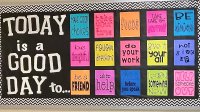Making the Most of Your Classroom Walls
Classroom walls don’t have to be Instagram-worthy so long as they display the right information and allow students to shine.
Your content has been saved!
Go to My Saved Content.The “Pinterest teacher”: We can all picture the perfectly decorated classroom, seasonally aligned themes, expertly crafted posters—a classroom any child would be excited to spend time in. I, however, am no Pinterest teacher. I have never had the artistic skill or creative ability to make my classroom look anything like the pictures I see online.
If you’re like me, you might be ready to come to terms with the fact that your classroom will never be worthy of thousands of Instagram likes, but that doesn’t mean you can’t create an incredibly rich, informative, and welcoming space for your students. Below, I outline four things that help me make the most of my classroom walls in a way that feels authentic and reflects my students.
4 Essentials for Classroom Walls
1. Content anchor charts: While my anchor charts aren’t always the prettiest, they are incredibly helpful for my students, and I make sure to have multiple anchor charts in their view during class. Anchor charts help consistently expose students to key concepts, vocabulary, and important notes.
To make the most of your anchor charts, create them with your students and update them as needed. When I first started teaching, I would make a ton of math-related anchor charts and just throw them up on the walls for the whole year. My students barely took note of them and didn’t connect the individual anchor charts to the units we were actively learning.
Now, I make my anchor charts during the individual lesson they align with best so students are involved in making the anchor chart and posting it in the room. I have seen my students be far more invested in referencing the anchor charts they had a hand in creating.
Additionally, by rotating my anchor charts during each unit, my walls are far less crowded, and my students can quickly recognize what the most important information is for them to focus on during the lesson. If certain anchor charts are always important, feel free to keep those on the walls all year, but consider putting them to the side or up higher on your walls to give the current topic’s anchor charts the prime space.
2. Reminders of the rules: A second type of poster to keep on your walls is reminders of specific classroom rules and policies. This is helpful to continually ground students in the classroom expectations and how to demonstrate excellence.
Depending on the age of the students and your specific classroom policies, this might look like a consequence ladder, a description of how to hand in work, an explanation of what students should do when they need something during class, or sentence starters for engaging in classroom conversation. In my own space, I have a poster with the classroom expectations as well as a poster of our school’s values visible for students.
3. Academic Hall of Fame: The next way to make the most of classroom space is through the creation of an Academic Hall of Fame. This is a space dedicated to showing off exceptional student work and should be consistently updated to ensure all students have the opportunity to be recognized. In the past, I have had a bulletin board on which I stapled sheet protectors so I could easily slip pieces of student work in and remove them without potentially ripping the work.
To further build on this, you can even post a photo of the student next to their work or keep a separate space dedicated to pictures of students who have been honored as classroom MVPs (or whatever other positive behavioral interventions and supports incentives you have).
The key to investing students in your Academic Hall of Fame is not only to ensure everyone has an opportunity to be showcased but to consistently reference it and make a point of sharing it with families. I will award students for academic growth as well as academic excellence and do my best to update families when their students have been recognized.
4. Student showcase: Lastly, and maybe my favorite way to help students see the classroom as a space they belong in, you can use your walls to showcase your students’ nonacademic talents and activities.
In my class, I have multiple students who are talented artists and writers. Anytime they complete a piece and show it to me, I offer to hang it on the bulletin board I have dedicated to showing off nonmathematical class content. Almost every time, my students are so excited to have me hang up their work.
It’s incredibly empowering for students, especially those who may struggle with your specific content, to see something they did or something they created on display in the space.
Beyond drawings, song lyrics, and short stories, I also do my best to photograph special moments throughout the school year and hang those photos on my walls as well. Whether it’s in photos of a twin day at school, the basketball team after a win, or my students marching in the most recent Mardi Gras parade, my students love to see themselves reflected on the walls of our room.
